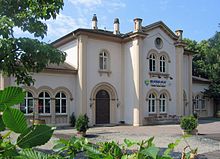Hanau-Wilhelmsbad train station
| Hanau-Wilhelmsbad | |
|---|---|
|
Station building on the track side
|
|
| Data | |
| Operating point type | Breakpoint |
| Platform tracks | 2 |
| abbreviation | FHWB |
| IBNR | 8002574 |
| Price range | 5 |
| opening | September 10, 1848 |
| Profile on Bahnhof.de | Hanau-Wilhelmsbad |
| Architectural data | |
| architect | Julius Eugen Ruhl |
| location | |
| City / municipality | Hanau |
| country | Hesse |
| Country | Germany |
| Coordinates | 50 ° 8 '38 " N , 8 ° 53' 1" E |
| Railway lines | |
|
|
| Railway stations in Hessen | |
The Hanau-Wilhelmsbad Bahnhof is a former Fürstenbahnhof and today breakpoint at the Frankfurt-Hanau Railway in Hanau .
function
It was built in the immediate vicinity and with reference to the Wilhelmsbad bathing facility and served the excursion traffic to there. Shortly after the opening, if the weather is good, up to 16,000 people are said to have traveled by train on public holidays. Today the station is used by numerous commuters due to a large parking lot in the immediate vicinity. Outside of rush hour, however, this stop is not very busy. It has two outer platforms that are only connected to each other by the neighboring level crossing on Burgallee . Furthermore, the station connects the nearby Herbert-Dröse-Stadion to the rail traffic.
Reception building
The station building is one of the oldest preserved in Hessen . It was put into operation on September 10, 1848. The architect was Julius Eugen Ruhl . He placed it directly at the intersection of Hochstädter Landstrasse and Burgallee , the connection between Wilhelmsbad Park and Philippsruhe Palace , which was the electoral residence at the time the station was built. The reception building therefore originally had an unusual floor plan: The reception area for the Elector was in the middle, thus cutting up the areas for "normal" travelers. One side was intended for 1st and 2nd class travelers, the other for 3rd class travelers. A ticket office was only available in the 3rd class area. The building was privatized in the 1990s and has been used for gastronomy ever since. The reception building is a cultural monument according to the Hessian Monument Protection Act . Today it can be counted as part of the architectural ensemble of the Wilhelmsbad park.
Planning
The already mentioned level crossing , with which the Burgallee crosses the railway line, is still at the same level today and on the busy main line an obstacle for both railway operations and road traffic. It is to be eliminated in the course of the Nordmainische S-Bahn . However, it is not known when this expansion will take place. Plans for this go back to the 1970s. Also noticeable is the sharp incline of the tracks caused by curves, which has led to numerous sliding contacts with motor vehicles, and the traces of which are visible in the transition area.
|
←
|
Lines |
→
|
||
|---|---|---|---|---|
| Main valley east |
Frankfurt – Maintal – Hanau |
Hanau West | ||
literature
- Gerhard Bott: healing exercise and amusement. The Hereditary Prince's Wilhelmsbad. CoCon-Verlag, Hanau 2007, ISBN 3-937774-36-X .
- Heinz Schomann : Railway in Hessen . Railway history and building types 1839–1999 / Railway buildings and lines 1839–1939. In: State Office for Monument Preservation Hessen (Ed.): Cultural monuments in Hessen. Monument topography Federal Republic of Germany . Three volumes in a slipcase. tape 2.1 . Theiss Verlag, Stuttgart 2005, ISBN 3-8062-1917-6 , p. 126 .
- Rolf Reutter: The royal train station. A closed chapter in architectural history. In: Monument Preservation and Cultural History , issue 4/2008, pp. 27–30.
Web links
Individual evidence
- ↑ Query of the course book route 640 at Deutsche Bahn.
- ↑ Query of the course book route 641 at Deutsche Bahn.
- ↑ Bott, p. 237.
- ↑ Reproduction of the building plans in: Bott, p. 236.
- ^ Siegfried Lohr : Planning and buildings by the Kassel master builder Julius Eugen Ruhl 1796–1871. A contribution to the building history of Kassel and Kurhessen in the 19th century . Masch. Diss. Darmstadt [1982], pp. 357-359.
- ↑ Bott, p. 234ff.



